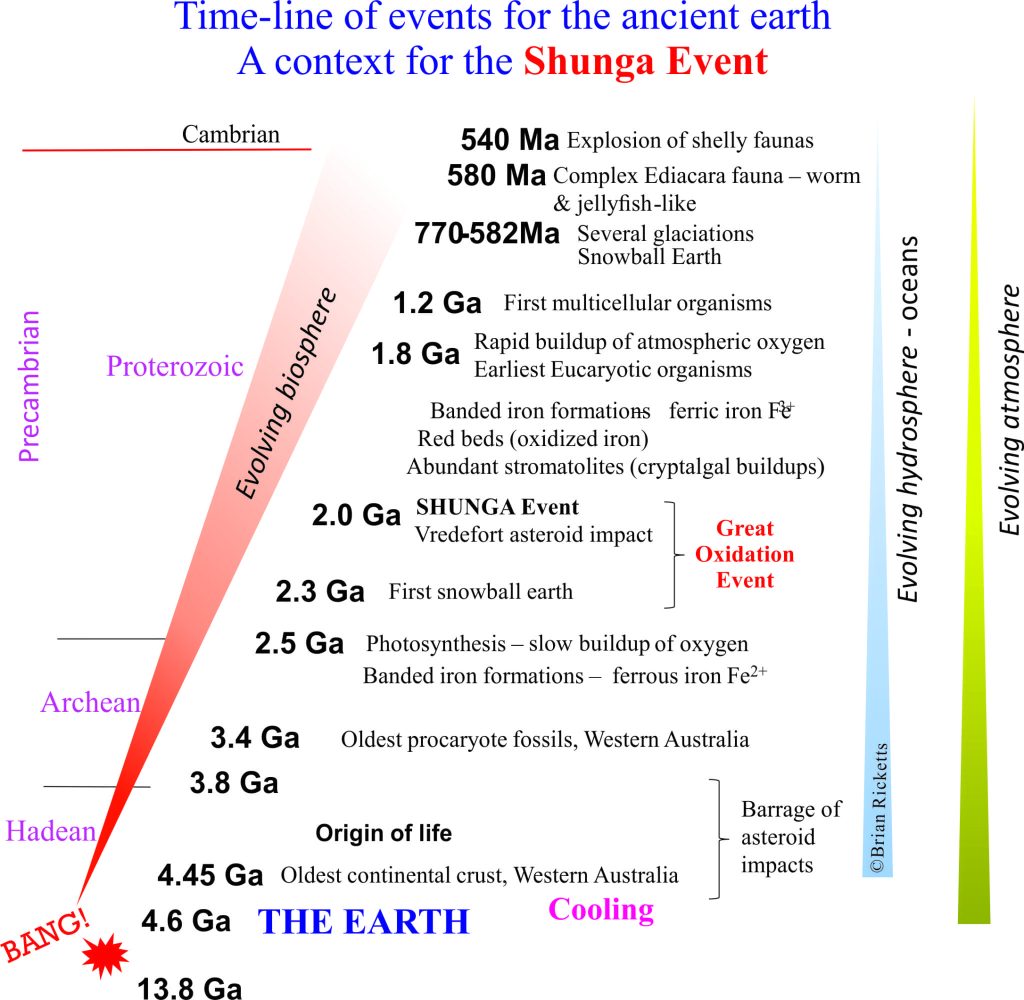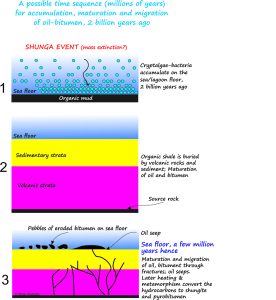Earth continues to evolve. So far it has taken, notwithstanding Bishop Ussher’s different view of things, about 4.6 billion years for the atmosphere, hydrosphere, lithosphere (the solid earth), and biosphere to get to where they are today. Over that time there have been (rewording a well-known expression) long geological periods of inexorably slow change punctuated by catastrophes. Mass extinctions, caused by blink-of-an-eye bolides and episodes of rampant volcanism (e.g. the Deccan Traps), completely changed the course of biological evolution. Contrast events like these with the life and death of oceans counted over 100-200 million years. Meteorites, volcanoes, and glaciations have all played their part in moulding our planet.
The Shunga Event, not to be confused with traditional (Shunga) erotic Japanese art, is one such event that still mystifies geologists. It involved the demise of a massive, primitive biomass that ultimately was converted to one of the oldest known petroleum deposits – about 2000 million (2 billion) years ago.
A global context
Two billion years ago, global temperatures were probably quite warm, even tropical in places; the earliest known glaciation (the Huronian Glaciation) had ended about 200 million years earlier (this geological period is referred to as the Paleoproterozoic). It was a time of prolific biomass development, primarily in the form of stromatolites (structures made up of laminated, primitive cryptalgae -basically fossil slime). Oxygen levels in the atmosphere were gradually increasing, derived from photosynthesis by primitive algae and bacteria – the period from 2.3 to 2.0 billion years has become known as the Great Oxidation Event.Deposition of iron-rich sediment (oxidized iron), the Banded Iron Formations, was also widespread.
The Shungite deposits in northwest Russia; an ancient oil field
The mineral Shungite is composed of pure carbon, and forms rock that looks like anthracite (a high rank coal); it is shiny (lustrous), and tends to break along curved, conchoidal planes. Shungite is amorphous (does not have crystal structure), unlike graphite (another form of pure carbon) which grows as hexagonal-shaped crystals. It is named after the village of Shun’ga on Lake Onega, northwest Russia, not far from the Finnish border.
The 2 billion year-old deposits of Shungite in the Lake Onega region, about 600m thick, form sedimentary layers, fill cracks and fractures in overlying volcanic rocks, and even form diapir-like structures; they are interlayered with volcanic rocks (the geological unit is called the Zaonega Formation). The carbon content in places is as high as 98%, and averages 25% (what an amazing petroleum source rock this must have been). Estimates, based on detailed mapping, indicate carbon reserves of 2.5 x 1011 tonnes. Putting this into context, the Shunga reserves are about one quarter the proven global reserves of coal (8.92 x 1011 tonnes). Clearly, this is a massive deposit of carbon. Most of the carbon is considered to be organic, derived from primitive bacteria- and algae-like organisms. This conclusion is based on rock chemistry, in particular the abundance of the stable 12C isotope, and evidence of original deposition in brackish lagoon or marsh-like environments.
Interpretation of the Lake Onega rocks as ancient petroleum deposits is based on migration structures such as small, intrusive diapirs, and fractures that were filled by a mobile fluid, probably bitumen. Some petroleum fluid must also have seeped to the ancient sea floor (much like modern oil seeps), where exposed petroleum or bitumen was eroded and pebble-like bitumen clasts subsequently incorporated into other sediment. Continued burial and heating of the ancient petroleum eventually metamorphosed it to pyrobitumen and shungite.
A global extinction?
Organic carbon-rich deposits of about the same age and having similar carbon isotope chemistry have been found elsewhere in northwest Russia, and in North America, Greenland and West Africa. Many scientists now consider these deposits to represent a global event, although the nature and cause of the event remains something of a mystery. Do the organic accumulations represent a global extinction of certain ancient microbes? Clearly, not all microbes became extinct because younger rocks contain abundant stromatolites and other cryptic algal (ancient slime) structures. And if this was an extinction event, what caused it?
Changing ocean chemistry and oceanic water-mass overturn are a couple of candidates. Another tempting possibility is the devastation wreaked by a meteorite impact, in particular the Vredefort impact, discovered in South Africa. The Vredefort is currently the oldest (about 2000 million years) and largest known terrestrial impact structure; the crater is estimated, from geological mapping, to have been about 300km in diameter (about twice the diameter of Chicxulub Crater). Given the havoc generated by the Chicxulub event 65 million years ago, it isn’t difficult to imagine the devastation caused by the much larger Vredefort impact.
The jury is still deliberating on the cause and effect of these Shunga deposits but like many questions science has about the really ancient earth, it continues to fascinate.




















2 thoughts on “The Shunga Event; did a Precambrian mass extinction give rise to an ancient supergiant oil field?”
Many among the geoscientific community are reluctant to nurture the idea of much deeper petroleum system. Hard evidence such as the one reported here may hopefully open up fresh thinking about the petroleum origin.
Existence of Protorozoic source rock is known in some parts of the Middle East basins. Relating it with these older sediments of Russian basin may be interesting. It will also help to figure out the proto-Gondwana basins.
Pingback: homepage